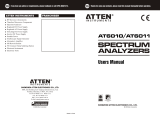
Page 14 of 28
INSTRUCTION MANUAL
CLCI-100 BULK CURRENT INJECTION PROBE
with FCLC-100 CALIBRATION FIXTURE
19121 El Toro Rd ● Silverado, California 92676 ● (949) 459-9600 ● com-power.com
REV051917
4.2 Insertion Loss/Coupling Factor Measurement
Illustrated in Figures 6 and 7 are typical setups for the measurement of a current
probe’s insertion loss, also known as coupling factor. Figure 6 shows the setup for
a 50 ohm system (100 ohm loop); and Figure 7 shows the setup for a 150 ohm
system (300 ohm loop).
The insertion loss/coupling factor is essentially the difference between the voltage
present on the conductor(s) passing through the current probe aperture and the
voltage present at the output of the probe. These two quantities are depicted as
V
1
and V
2
, respectively, in Figure 8; where V2 - V1= Insertion Loss/Coupling Factor.
FIGURE 6 - Setup for Insertion/Coupling Loss in a 50Ω System (100Ω Loop)
FIGURE 7 - Setup for Insertion/Coupling Loss in a 150Ω System (300Ω Loop)
CLCI-100
Bulk Current Injection Probe
10 kHz to 100 MHz
Max Input: 100 Watts (CW)
www.com-power.com
CAUTION
Hazardous voltages present
during operation. Do not handle
probe while test is in progress.
FRONT VIEW
www.com-power.com
FCLC-100
CLCI-100
Bulk Current Injection Probe
10 kHz to 100 MHz
Max Input: 100 Watts (CW)
www.com-power.com
CAUTION
Hazardous voltages present
during operation. Do not handle
probe while test is in progress.
L
I-1
Bulk Current Injection Probe
Max In
: 100 Watts
www.
-
w
.
AUTI
azar
ous vo
tages presen
ur
eration. Do not handl
probe while test is in pro
ress
GROUND PLANE
10 dB
10 dB
NORMALIZATION CALIBRATION - 50Ω SYSTEM (100Ω LOOP)
OUTPUT
RF
Network Analyzer
with
S-Parameter Capabilities
- or -
Spectrum Analyzer/EMI Receiver
with
Tracking Generator
- or -
Synthesized Signal Generator
and
Spectrum Analyzer/Receiver
INPUT
RF
TOP VIEW
OUTPUT
RF
Network Analyzer
with
S-Parameter Capabilities
- or -
Spectrum Analyzer/EMI Receiver
with
Tracking Generator
- or -
Synthesized Signal Generator
and
Spectrum Analyzer/Receiver
INPUT
RF
50Ω
10 dB
10 dB
CLCI-100
Bulk Current Injection Probe
10 kHz to 100 MHz
Max Input: 100 Watts (CW)
www.com-power.com
CAUTION
Hazardous voltages present
during operation. Do not handle
probe while test is in progress.
FRONT VIEW
www.com-power.com
FCLC-100
CLCI-100
Bulk Current Injection Probe
10 kHz to 100 MHz
Max Input: 100 Watts (CW)
www.com-power.com
CAUTION
Hazardous voltages present
during operation. Do not handle
probe while test is in progress.
L
I-1
Bulk Current Injection Probe
Max In
: 100 Watts
www.
-
w
.
AUTI
azar
ous vo
tages presen
ur
eration. Do not handl
probe while test is in pro
ress
ADA-
515-2
ADA-
515-2
GROUND PLANE
10 dB
10 dB
NORMALIZATION CALIBRATION -150Ω SYSTEM (300Ω LOOP)
OUTPUT
RF
Network Analyzer
with
S-Parameter Capabilities
- or -
Spectrum Analyzer/EMI Receiver
with
Tracking Generator
- or -
Synthesized Signal Generator
and
Spectrum Analyzer/Receiver
INPUT
RF
TOP VIEW
OUTPUT
RF
Network Analyzer
with
S-Parameter Capabilities
- or -
Spectrum Analyzer/EMI Receiver
with
Tracking Generator
- or -
Synthesized Signal Generator
and
Spectrum Analyzer/Receiver
INPUT
RF
50Ω
10 dB
10 dB




















